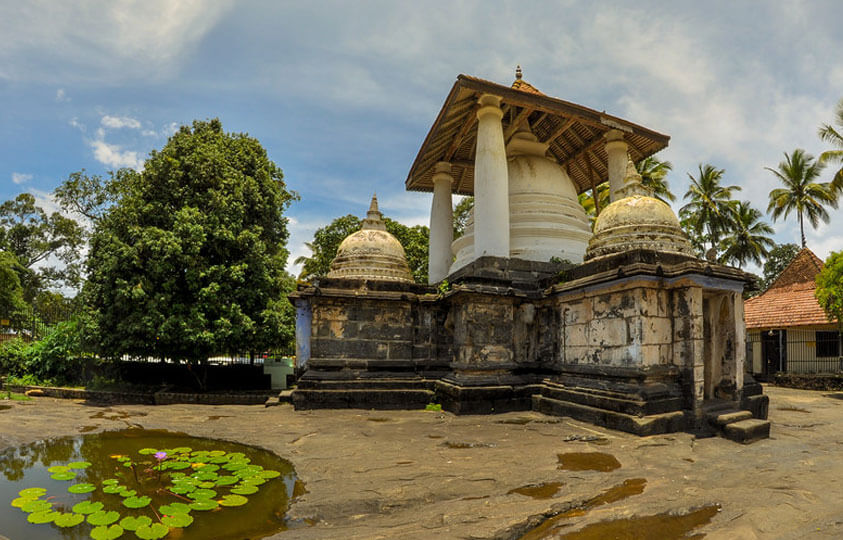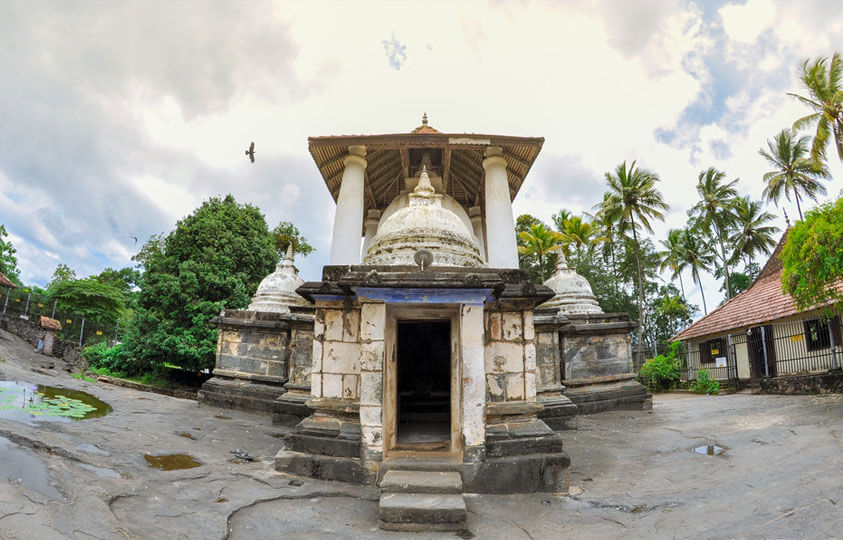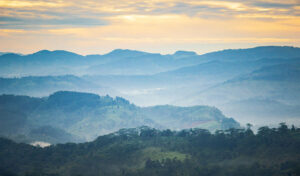A symbol of the growing prominence of Gampola, Gadaladeniya Raja Maha Viharaya was built over a rock in Diggala by King Buwanekabahu IV in 1344AD. Together with its sister temple, Lankathilaka Viharaya, this majestic monastery helped to affirm Gampola as the capital of ancient Sri Lanka, moving the seat of power away from the former kingdom of Kurunegala.
The elevated central stupa, known as ‘Vijayothpaya’ is believed to be the residence of God Sakra. It is sheltered by a roof, vesting it with an added sense of spirituality and respect. Surrounding this central stupa and positioned at a slightly lower level are four satellite stupas, representing the four guardian deities of Sri Lanka: Uppalavan, Saman, Vibishana and Skanda. These stand atop four image houses.
Gadaladeniya is renowned for its stone carvings and murals within the main shrine room. Flanking the entrance are two unusual triple columns each hewn out of a single stone. These columns are adorned with intricate carvings of images from Hindu mythology and belief, including figures of deities, episodes from Puranic legends and the figure of Shiva performing the cosmic dance. This incorporation of Hindu deities into Buddhist places of worship was initiated in the Gampola period, with the Gadaladeniya Temple being one of the first to do so. The asymmetry of the two columns is said to be because they were constructed by two different people – the right one being made by the chief architect Ganeshwaracharya and the left being done by one of the best stone smiths in the country.
The elevated central stupa, known as ‘Vijayothpaya’ is believed to be the residence of God Sakra. It is sheltered by a roof, vesting it with an added sense of spirituality and respect. Surrounding this central stupa and positioned at a slightly lower level are four satellite stupas, representing the four guardian deities of Sri Lanka: Uppalavan, Saman, Vibishana and Skanda. These stand atop four image houses.
Gadaladeniya is renowned for its stone carvings and murals within the main shrine room. Flanking the entrance are two unusual triple columns each hewn out of a single stone. These columns are adorned with intricate carvings of images from Hindu mythology and belief, including figures of deities, episodes from Puranic legends and the figure of Shiva performing the cosmic dance. This incorporation of Hindu deities into Buddhist places of worship was initiated in the Gampola period, with the Gadaladeniya Temple being one of the first to do so. The asymmetry of the two columns is said to be because they were constructed by two different people – the right one being made by the chief architect Ganeshwaracharya and the left being done by one of the best stone smiths in the country.


The name Gadaladeniya means ‘stones brought from Deniya’ referencing the place where the raw materials were sourced from. Legend has it that 1,000 stone smiths from India worked together with a group of Sri Lankan artisans, spending 30 years building the temple. The successors of King Buwanekabahu IV kept developing the original temple, with an exceptional amount of effort being taken by King Wickramabahu III. In a very tragic turn of events, the Gadaladeniya Temple was severely damaged by the Portugese invaders. While a fair amount of restoration work has been carried out, the damage is evident today in the art and inscriptions.
Regardless of its historical vicissitudes, the Gadaladeniya Raja Maha Viharaya is still an impressive structure. The combination of unusual architecture, comely carvings and spiritual significance place it as a temple of consequence not just in Gampola but in Sri Lanka in general.
Regardless of its historical vicissitudes, the Gadaladeniya Raja Maha Viharaya is still an impressive structure. The combination of unusual architecture, comely carvings and spiritual significance place it as a temple of consequence not just in Gampola but in Sri Lanka in general.




